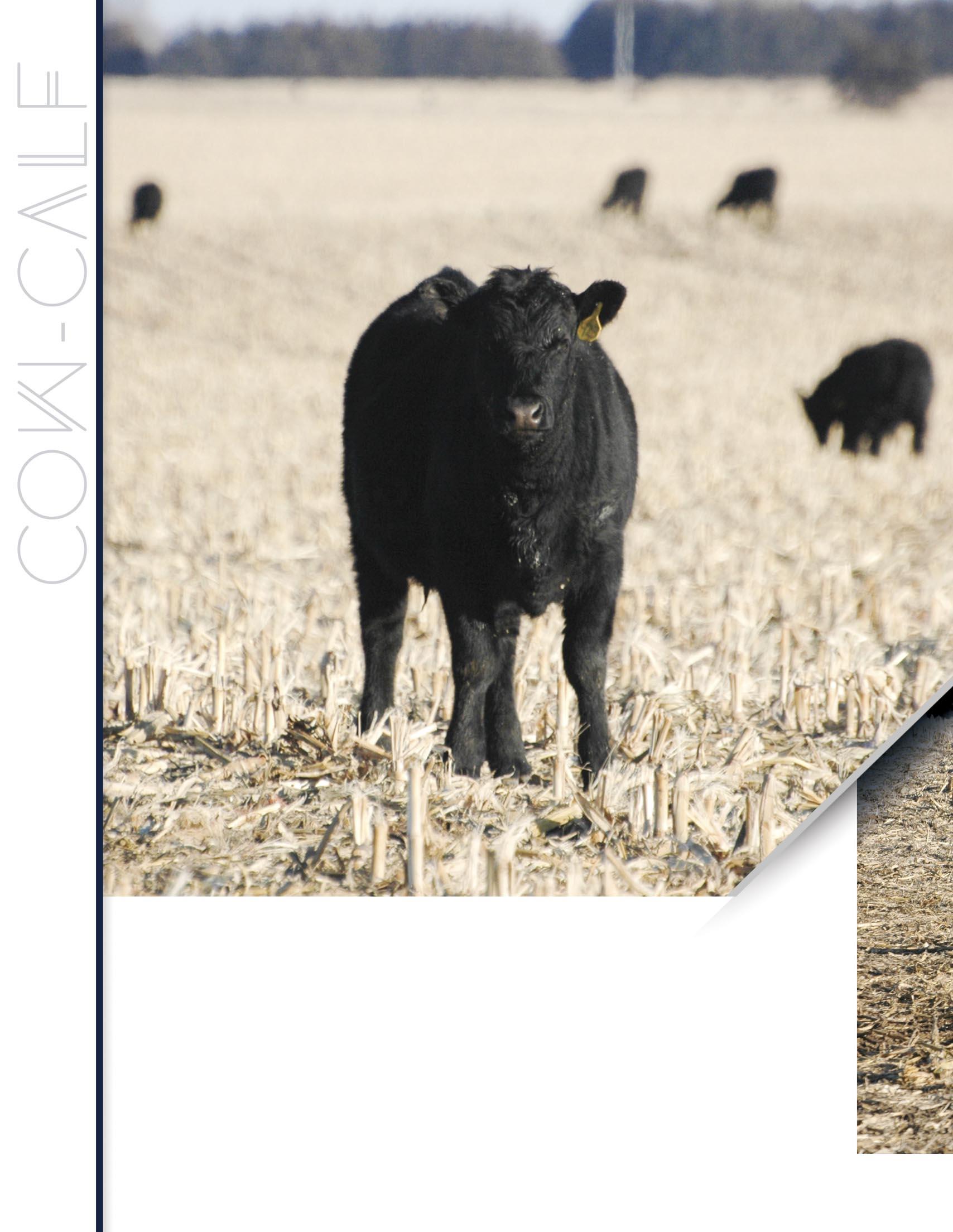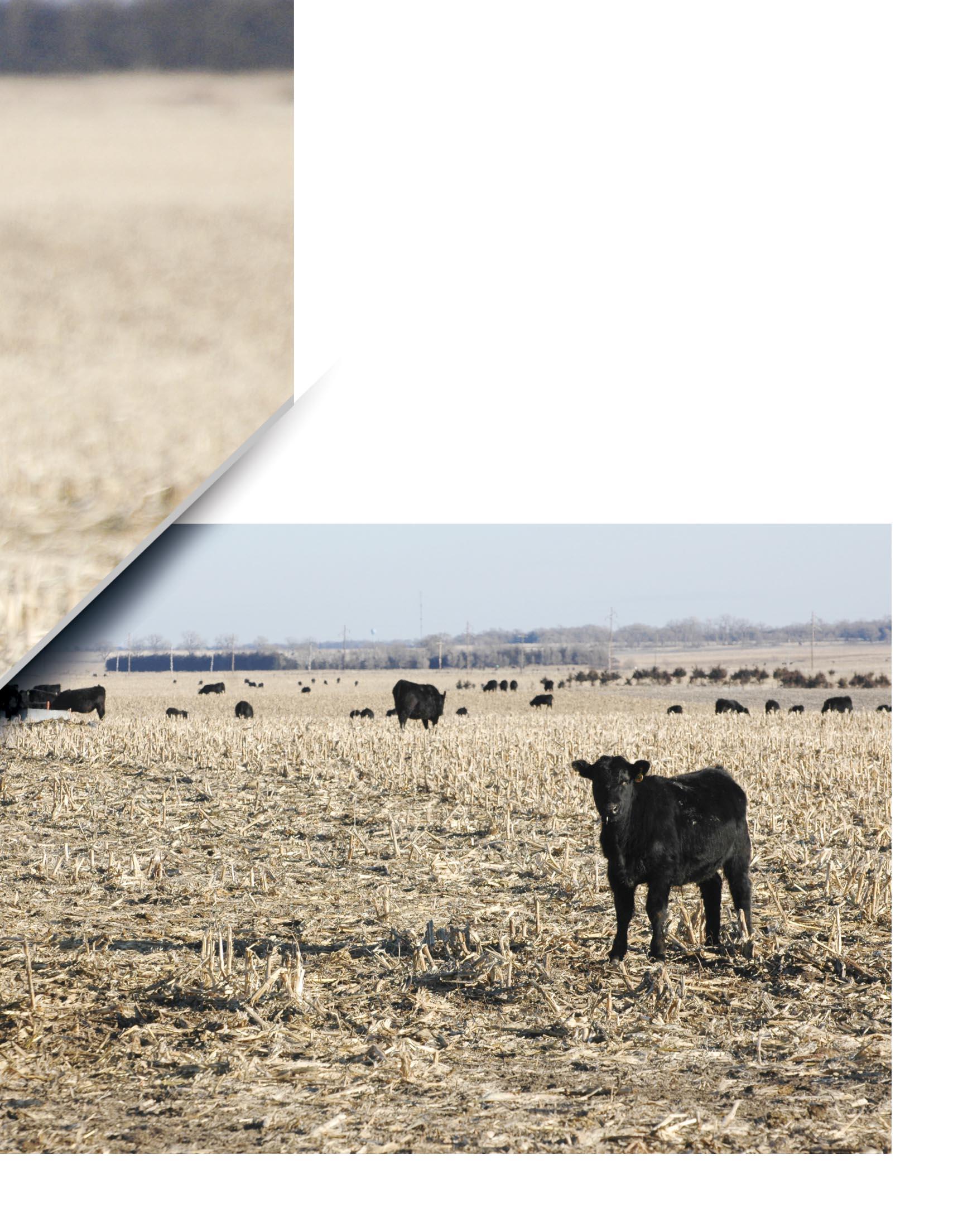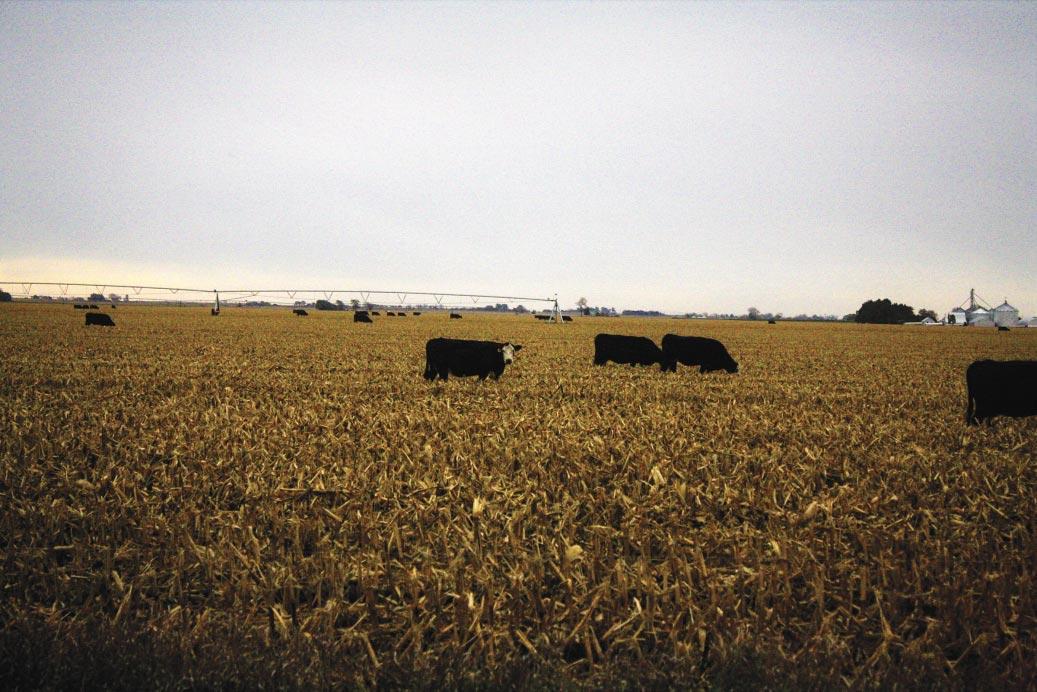
5 minute read
WHAT DO YOU NEED TO PROVIDE WHEN GRAZING CORN RESIDUE?
By Dr. Mary Drewnoski, University of Nebraska-Lincoln
One of the most beautiful sights in Nebraska is that of a cow grazing corn residue in the fall and winter. Cattle will select for the most nutritional components in the field: the grain, the husk, and the leaf. Typically in today’s fields, there is not much grain available, but even when just grazing husk and some leaf, a pregnant cow can often maintain body condition without any supplemental protein or energy. Our data and experience suggest that as long as the stocking rate matches the amount of available husk and leaf, a dry cow does not need any protein or ener gy suppleme ntation.

University of Nebraska has evaluated dry (but pregnant) cow supplementation strategies and found that there were no differences in pregnancy rates or performance of the offspring (including future breeding ability of the heifers) of cows receiving either 2.2 lb per day of dry distillers grains or no supplementation. The stocking rate is the key. We recommend that stocking rate of a corn field be tied to corn yield, with 1 cow month for every 100 bushels of corn produced. For example, if you had an 80-acre field that averaged 150 bushels/acre, the field would have 120 cow months of grazing in it. That results in the cows cleaning up almost all the husk and some of the leaf. That said, in wet years, they may need to be removed earlier due to increased trampling losses. It is best to keep an eye on the field and when it becomes hard to find husk, it is time to move. Regardless of conditions, cows do need supplemental minerals and vitamin A to meet their needs (Table 1).
The scenario changes for the summer/fall calving cow that is lactating while she is grazing corn residue. It is clear that the energy demands of lactation necessitate supplementation. However, the amount of supplement that is needed may vary. Summer calving cows that are in good body condition going into winter can lose body condition without having detrimental effects on their subsequent performance. In a study conducted in both eastern and western Nebraska, lactating cows (June and July calving; 1185 pounds) were provided 5.3 lb dry matter of distillers grains in bunks alongside their calves. Cows lost 0.7 units of body condition from November to April, but reproductive performance did not suffer. These cows started in good body condition (5.5) in November. Additionally, they gained condition prior to breeding such that they were BCS of 5.1. Thus, the extra body condition that many summer calving cows gain during summer grazing on pasture or being fed in a drylot can be used as a source of supplemental energy. However, summer calving cows going into the winter at lower BCS would need to be supplemented at greater rates to maintain BCS.
If calving in August or later, and cows are being bred when grazing corn residue, it is important to meet their energy and protein needs during the breeding season. A cow in peak lactation, which happens around breeding, would require 7 lbs of distillers dry matter to maintain condition (i.e., meet her energy and protein needs). If supplementing distillers to lactating cows grazing corn residue, a free choice 4 oz mineral that had no phosphorus, high calcium (20%), high magnesium (10 to 13%), as well as copper, zinc, selenium, and vitamin A in similar amounts as suggested for dry cow mineral (Table 1) would meet her micronutrient needs.
Weather can have a huge impact on the energy requirements of cattle. Cold temperatures increase energy requirements, especially when coupled with a wet hair coat or high winds. A cow in good BCS that has a heavy winter coat and is dry does not have to use energy to stay warm if wind chill is above 19 degrees F. When wind chill is below 19 degrees F and/or the cow has a wet hair coat, she will have to use energy to stay warm. Providing wind protection can decrease energy needs by removing wind as a factor, but with extremely cold temperatures or wet hair coats, additional energy supplementation maybe needed to maintain condition.

Having a good body condition score (5.5 BCS) is a risk management strategy, as they can often lose some condition without resulting in production losses. Good body condition also provides insulation and thus decreases the temperature at which they must start using energy to stay warm. Producers should monitor their cows closely to make sure cows maintain an acceptable level of condition for their stage of production. Typically, we target having spring cows in a BCS of 5.0 going into the spring breeding season whereas a BCS of 4.0 at spring weaning is acceptable for fall cows.
Winter supplementation strategies for weaned calves differ because the growing calf has a high protein requirement. Additionally, much of the protein that is needed must bypass rumen degradation to supply amino acids to the small intestine. To illustrate this point, we compared supplementation of corn and distillers grains to calves grazing corn residue. The energy content of distillers is 108% TDN and is much greater than corn at 82% TDN. When fed at equal energy consumption (i.e., providing more corn than distillers), the distillers grains-fed steers gained a pound per day more than the steers supplemented with corn. Adding protein to the corn in the form of urea only made up 20% of the difference in gain between the corn and distillers grains supplemented groups. Based on data from several trials, a reasonable estimate of the amount of distillers that is needed to produce a targeted rate of gain is shown in Table 2. This assumes proper stocking rates of 1 calf month per 50 bushels of corn produced. However, again weather can have a large impact on performance, with wet weather appearing to have the greatest negative impact.
In forage-based systems, we observe similar performance with dry, modified, and wet distillers as long as the same amount of dry matter is fed. It is important to note that the estimates are based off of calves being fed in a bunk. Feeding on the ground will increase waste and thus increase the amount needed. In trials, evaluating the waste with ground feeding, waste of 5% was measured for modified distillers, 20% for wet distillers and as much as 40% for dry distillers when compared to bunk feeding.
There are many supplementation options available in addition to distillers grains. Many of them provide added convenience in handling, delivery and/or potential waste. However, distillers is often the lowest cost source of both energy and protein in Nebraska (even when transported to locations far from the source). When considering using a feed because of its added convenience or reduced waste, it is still a good idea to price the feedstuffs on a cost per lb of nutrient needed (e.g., lb of TDN or lb of protein); that way you can figure out if these factors are worth the extra cost. Note: with growing cattle, the need for bypass protein results in there being few options that can result in similar performance at a lower cost than distillers even at high prices.
Dr. Mary Drewnoski is a Beef Systems Specialist with the University of Nebraska-Lincoln. Prior to joining UNL in 2014, she spent time learning and working in cattle systems in many locations across the U.S. including: Kentucky, North Carolina, Iowa, and Idaho. She is a beef cattle nutritionist with expertise in forage production systems and is a part of an interdisciplinary team evaluating Economical Systems for Integrated Crop and Livestock Production











